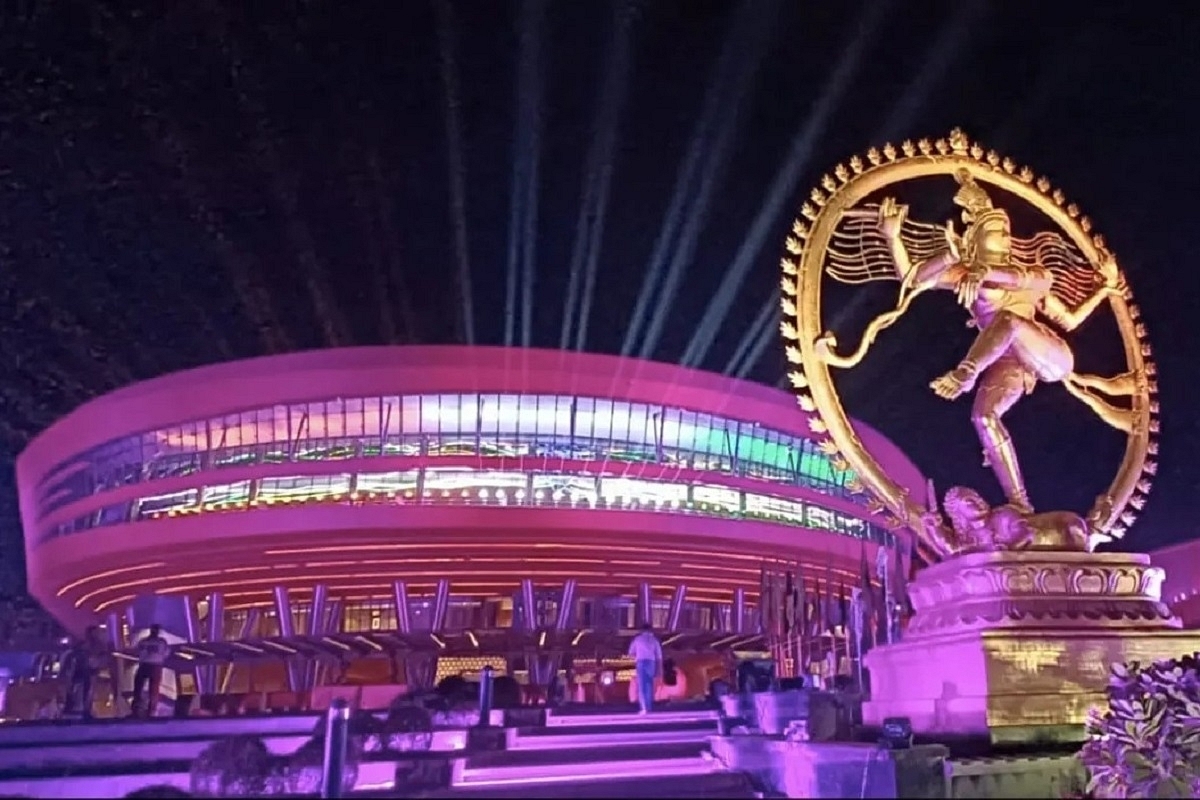Culture
Meet The Sculptors Behind G20 Summit's Nataraja Towers, Carrying Forward Chola Era Craftsmanship

27-foot Nataraja statue in front of Bharat Mandapam.
When the G20 Summit takes place at Bharat Mandapam this weekend, world leaders will be greeted by a magnificent statue of Nataraja, Lord Shiva in his cosmic dance form. Standing at a towering height of 27 feet, the statue dominates the venue.
The Nataraja sculpture, created by highly skilled artisans hailing from Swamimalai in Tamil Nadu's Thanjavur district, carries a legacy that spans 34 generations, all the way back to the Chola era.
This lineage has a significant historical connection, particularly in their contribution to the construction of the magnificient Brihadeeshwara Temple, reflecting their profound heritage and remarkable craftsmanship displayed in their outstanding creatio
The statue is a masterpiece crafted from an ashtadhatu (eight-metal alloy). Weighing a staggering 18 tonne, it required a trailer with 36 tires to transport it to Delhi.
The creators of the statue describe it as a perfect blend of tradition and modernity.
As per a report by The Indian Express, Srikanda Sthapathy, a 61-year-old sculptor who worked on the statue alongside his brothers Radhakrishna Sthapathy and Swaminatha Sthapathy, expressed their overwhelming joy at the recognition and numerous congratulatory phone calls they received.
Trained in the ancient gurukul system, the Sthapathy family was chosen to undertake the Nataraja project after meeting strict criteria set by the Indira Gandhi National Centre for the Arts, Ministry of Culture.
"Our expertise in crafting numerous significant statues, along with successful completion of over 300 orders in five years and providing GST details, were crucial factors in the tender process," stated Srikanda.
The design of the statue takes inspiration from three revered Nataraja idols: the Thillai Nataraja Temple in Chidambaram, the Uma Maheswarar Temple in Konerirajapuram, and the UNESCO World Heritage Site of Brihadeeshwara Temple in Thanjavur.
The traditional 'lost-wax' casting method, which originated in the Chola era, was employed in the crafting process. Initially, a wax model was meticulously created, adorned with intricate ornaments. The entire mold was then coated with a unique alluvial soil paste, exclusively found in Swamimalai.
What makes this method unique is the use of Cauvery clay sourced from a specific section of the river at Swamimalai.
The process involves drying the clay in the sun and applying multiple coatings. This allows the wax inside the mold to melt away, creating space for the liquid metal to be poured in.
Once the mold has cooled, it is carefully broken to reveal the statue, which is then meticulously chiseled, filed, and engraved to achieve its ornamental finish. These steps are explained by Srikanda.
Originally, the statue was supposed to be made from panja loha, but it was later decided to craft it from ashtadhatu (eight-metal alloy).
Throughout the project, a delegation provided feedback on the wax model, leading to minor alterations in the statue's limbs.
The creation of the base wax model was a collaborative effort between Srikanda and his two brothers. The entire project took seven months to complete.
The cost of the project is Rs 10 crore, including GST, according to Srikanda.
Support Swarajya's 50 Ground Reports Project & Sponsor A Story
Every general election Swarajya does a 50 ground reports project.
Aimed only at serious readers and those who appreciate the nuances of political undercurrents, the project provides a sense of India's electoral landscape. As you know, these reports are produced after considerable investment of travel, time and effort on the ground.
This time too we've kicked off the project in style and have covered over 30 constituencies already. If you're someone who appreciates such work and have enjoyed our coverage please consider sponsoring a ground report for just Rs 2999 to Rs 19,999 - it goes a long way in helping us produce more quality reportage.
You can also back this project by becoming a subscriber for as little as Rs 999 - so do click on this links and choose a plan that suits you and back us.
Click below to contribute.
Latest